

Evaluaciones a distancia: opciones y herramientas para docentes. Normalmente cuando buscamos aplicar la tecnología a las actividades comunes, aplicamos la metodología del reemplazo, es decir hacemos lo mismo pero con una nueva tecnología.
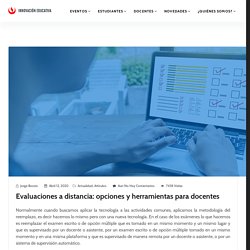
Herramientas e instrumentos para evaluar y retroalimentar a distancia. Como sabemos, la pandemia ha obligado a los docentes y alumnos a trabajar a distancia, por ello tanto el proceso de enseñanza-aprendizaje como las estrategias de evaluación han debido adaptarse a esta modalidad de trabajo.
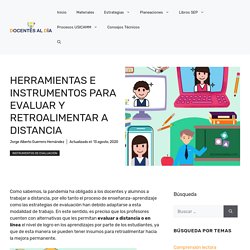
En este sentido, es preciso que los profesores cuenten con alternativas que les permitan evaluar a distancia o en línea el nivel de logro en los aprendizajes por parte de los estudiantes, ya que de esta manera se pueden tener insumos para retroalimentar hacia la mejora permanente. ¿Qué es la evaluación a distancia? Eight-Year Study - Purpose, Method, Results - School, York, Commission, and Curriculum - StateUniversity.com. Purpose, Method, Results The Eight-Year Study (also known as the Thirty-School Study) was an experimental project conducted between 1930 to 1942 by the Progressive Education Association (PEA), in which thirty high schools redesigned their curriculum while initiating innovative practices in student testing, program assessment, student guidance, curriculum design, and staff development.

Purpose By the late 1920s the members of PEA acknowledged that only one out of six American high school students continued on to college, yet conventional college preparation programs still dominated the basic course of study at the secondary school level. The Aikin Commission proceeded to select approximately thirty schools (including some school systems) that were freed to revise their secondary curriculum. Method. - Publisher of Open Access Journals. (1) Background: Although HIV has not diminished in importance in Canada, the field of HIV research remains small, and the graduate students who decide to pursue careers within it feel isolated and uncertain about their professional skills and opportunities.
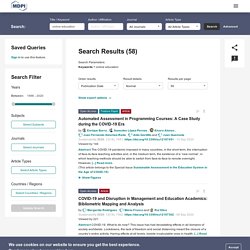
Universities Without Walls (UWW) was created in 2009 to help redress these shortcomings. The Impact of the COVID-19 Pandemic on User Experience with Online Education Platforms in China. During the COVID-19 pandemic, social education has shifted from face to face to online in order to avoid large gatherings and crowds for blocking the transmission of the virus.
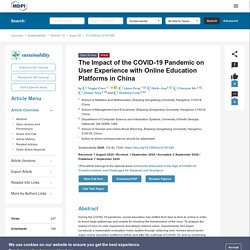
To analyze the impact of virus on user experience and deeply retrieve users’ requirements, this paper constructs a reasonable evaluation index system through obtaining user reviews about seven major online education platforms before and after the outbreak of COVID-19, and by combining the emotional analysis, hot mining technology, as well as relevant literature. At the same time, the variation coefficient method is chosen to weigh each index based on the difference of index values. Furthermore, this paper adopts the comprehensive evaluation method to analyze user experience before and after the outbreak of COVID-19, and finally finds out the change of users’ concerns regarding the online education platform. ►▼ Show Figures. Key Concepts. 'Key Concepts in ELT' is a feature of the Journal that aims to assist readers to develop an appreciation of central ideas in ELT, and to approach the content of articles from a perspective informed by current debate on aspects of theory and practice.
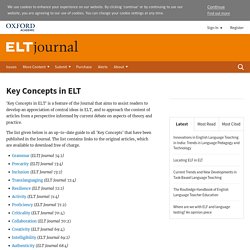
The list given below is an up-to-date guide to all 'Key Concepts' that have been published in the Journal. The list contains links to the original articles, which are available to download free of charge. Conectar Igualdad: los estudios muestran que las computadoras mejoraron el aprendizaje de los estudiantes - Chequeado.
Si tenés sólo unos segundos, leé estas líneas:
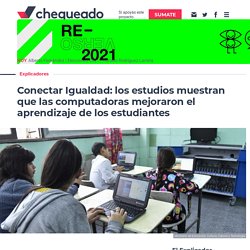
6.2 A short history of educational technology. Arguments about the role of technology in education go back at least 2,500 years.
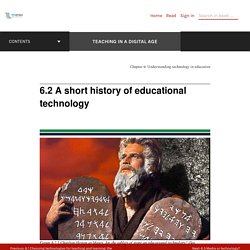
To understand better the role and influence of technology on teaching, we need a little history, because as always there are lessons to be learned from history. Paul Saettler’s ‘The Evolution of American Educational Technology‘ (1990) is one of the most extensive historical accounts, but only goes up to 1989. A lot has happened since then. Teemu Leinonen also has a good blog post on the more recent history (for a more detailed account see Leitonen, 2010). See also: The Evolution of Learning Technologies. What I’m giving you here is the postage stamp version of ed tech history, and a personal one at that. 6.2.1 Oral communication One of the earliest means of formal teaching was oral – though human speech – although over time, technology has been increasingly used to facilitate or ‘back-up’ oral communication. Phaedrus, 274c-275, translation adapted from Manguel, 1996.
What lessons from the coronavirus pandemic will shape the future of education? COVID-19 has highlighted issues entrenched in our global education system going back 200 hundred years - from inequality of funding between schools to a lack of focus on emotional wellbeing.

Will we return to traditional passive learning in front of a whiteboard, or move to a new path focused on student wellbeing and reducing the deep inequalities of global learning? You may have heard the idea that the Chinese word for crisis means “danger” also means “opportunity”. It is a compelling thought, but it is not true: the word for crisis in Chinese translates more properly as “threat at a point of juncture”. Indeed, the world is at a juncture that forks to the future, post post-lockdown.
Jrc121071. EDUCACION Y COVID-19 EN ARGENTINA – Educar 2050. Presentacion Rapid Assesstment UNICEF COVID19. COVID-19: UNICEF aporta evidencias sobre el impacto de la pandemia en la educación de los chicos y chicas de todo el país. Buenos Aires, 15 de mayo de 2020.- El 81% de los hogares donde viven niños, niñas y adolescentes está en contacto con el sistema educativo y recibe tareas escolares para realizar durante el aislamiento social, preventivo y obligatorio dispuesto para evitar el contagio de coronavirus (COVID-19, según sus siglas en inglés) con algunas diferencias por región.

BOLETIN OFICIAL REPUBLICA ARGENTINA - MINISTERIO DE EDUCACIÓN - Resolución 106/2020. Ciudad de Buenos Aires, 15/03/2020. Strategic Intelligence. Summaries of Learning Theories and Models - Learning Theories. Active Implementation Hub. The Active Implementation Hub is a free, online learning environment for use by any stakeholder — practitioners, educators, coaches, trainers, purveyors — involved in active implementation and scaling up of programs and innovations. The site goal is to increase the knowledge and improve the performance of persons engaged in actively implementing any program or practice.
While AI Modules and Lessons offer activities well-suited for many human service fields, the site currently focuses on active implementation and scaling up in the field of Education. Most e-learning content is appropriate for implementation teams, implementation specialists, administrators and technical assistance/professional development providers at any level in a system (e.g., district, region, state, national). Research Schools Network. Standard for teachers’ professional development. Sci-Hub: removing barriers in the way of science. Ijree v3n2p115 en. Teachers and technology use in the classroom. Information and communication technologies in teacher education: a planning guide - UNESCO Biblioteca Digital.
NETP17. Synthesis report future of education webnair 1. Summary emerging country level responses. Sg policy brief covid 19 and education august 2020. Jrc121071. s42438 020 00155 y. Log in. Mi perfil. Covid-19 insight reports. One report provides a snapshot of the policies and practice of ministries of education in 52 countries in managing the closure of schools and the provision of remote learning in the state primary and secondary sectors. A second report provides insight into the experience and professional needs of more than 9600 teachers and teacher educators from over 150 countries as they learn to support their learners remotely.
Covid19 Ministry of education snapshot 1 0. 9 Ways Online Teaching Should be Different from Face-to-Face. Five Norms and Five Rubrics for High-Quality Online Learning. Online learning is now a permanent part of school life. The COVID-19 pandemic forced schools to move online quickly, with little preparation. As weeks and months passed, two things became clear: 1) an “emergency” approach to online learning was not sustainable or advisable and 2) schools needed clarity and guidance in defining and designing for high-quality online learning. The issue of quality is an important one. After several months of doing their best in a crisis, schools now face higher expectations from students, their families, and teachers about how to design, deliver, and support online learning. Defining what online learning should look like in terms of core elements like relationships, rigor, assessment, and the roles of students and teachers is the first step in ensuring learners have the best, most meaningful experience possible.
Flash Feedback: How to Provide More Meaningful Feedback in Less Time. Encuesta Condiciones de Teletrabajo en emergencia – ADEIUNAJ. Esta encuesta es desde hace 3 años un relevamiento anual que desarrollamos desde nuestra organización. Diálogo: Docencia remota, retos y oportunidades. Blended learning in English language teaching: Course design and implementation. Cómo aplicar el aprendizaje basado en proyectos en diez pasos -aulaPlaneta. Diez consejos para aplicar el aprendizaje colaborativo en el aula -aulaPlaneta. El aprendizaje colaborativo se basa en el planteamiento de actividades en las que los alumnos tienen que trabajar en equipo e interactuar para conseguir un objetivo común. Sus ventajas son muchas: convierte a los estudiantes en protagonistas de su propio aprendizaje, desarrolla sus competencias y habilidades, refuerza sus relaciones interpersonales y les permite adquirir un aprendizaje significativo.
¿Qué aportan los entornos virtuales a la educación? Si os hablamos de entorno virtual de aprendizaje (EVA) o de LMS (learning management system, también virtual learning enviroment (VLE)) puede que no sepáis de lo que hablamos. Posiblemente si os hablamos de Moodle, Blackboard o Sakai la cosa os suene un poco más y, aún más posiblemente, hayáis utilizado alguna de estas herramientas. Aprendizaje Híbrido Flexible en el Entorno de la Educación Superior - Alfabetización Digital.
La eduación superior se caracteriza por estar en un cambio permanente en cuanto al proceso de enseñanza apredizaje, en la que se dinamizan los medios técnicos y tecnológicos por los cuales el estudiante se apropia del conocimiento. Es así que con la incorporación de las Tecnologías de la Información y Comunicación (TIC) al interior de las aulas, los paradigmas en cuanto a la forma y transmisión del conocimiento ha cambiado en las dos últimas décadas, y promenten seguir evolucionando hacia la omnipresencia y ubicuidad.
Oportunidades y retos de la modalidad hbrida en educacin superior. Nuevas Medidas frente al Coronavirus. Technological Pedagogical Content Knowledge (TPACK) for Pedagogical Improvement: Editorial for Special Issue on TPACK. Archambault, L. M., & Crippen, K. (2009). Examining TPACK among K-12 online distance educators in the United States Vol. 9. EJ868626. EJ918905. TPACK: Technological Pedagogical Content Knowledge Framework. Share on StumbleUpon0 shares on StumbleUpon. How COVID-19 Is Shaping Tech Use. What That Means When Schools Reopen.
—Illustration by Jori Bolton for Education Week EdWeek Research Center surveys reveal good and bad trends It might not be a tectonic shift yet, but the changes taking place in the K-12 tech landscape as a result of the coronavirus school closures are real and meaningful, and good and bad. That is what Education Week is learning as it surveys educators across the country about the impact school closures have had on their morale, student engagement, technology skills, and many other factors. In nationally representative surveys of teachers and district leaders, the EdWeek Research Center found that teachers reported their ability to use technology was rising during the school closures, online instruction was taking hold in some form in most places, and 1-to-1 computing opportunities were expanding gradually. But at the same time, huge tech-equity issues emerged, revealing challenges ahead whether school buildings reopen or not in the fall. 1.
Supporting the continuation of teaching and learning during the COVID 19 pandemic. The rise of online learning during the COVID-19 pandemic. The COVID-19 has resulted in schools shut all across the world. Globally, over 1.2 billion children are out of the classroom. As a result, education has changed dramatically, with the distinctive rise of e-learning, whereby teaching is undertaken remotely and on digital platforms. Research suggests that online learning has been shown to increase retention of information, and take less time, meaning the changes coronavirus have caused might be here to stay. While countries are at different points in their COVID-19 infection rates, worldwide there are currently more than 1.2 billion children in 186 countries affected by school closures due to the pandemic.
In Denmark, children up to the age of 11 are returning to nurseries and schools after initially closing on 12 March, but in South Korea students are responding to roll calls from their teachers online. BOLETIN OFICIAL REPUBLICA ARGENTINA - MINISTERIO DE EDUCACIÓN - Resolución 108/2020. Ciudad de Buenos Aires, 15/03/2020. Handbook of Technological Pedagogical Content Knowledge TPACK for Educators: Amazon.es: Herring, Mary C., Koehler, Matthew J., Mishra, Punya: Libros en idiomas extranjeros. Guidance for Using Technologies and Platforms. Guidance for Teachers. Learning in self-isolation: experts reflect on takeaways from remote studies. Worst practice in ICT use in education. KnoweldgePack COVID19 RemoteLearning LowResource EdTech. Results from Top Hat’s COVID-19 Student Survey about Online Learning - PhilOnEdTech.
COVID-19: How digital learning solutions are taking shape - ITU News. Supporting the continuation of teaching and learning during the COVID 19 pandemic. Guidances for online education by IITE and its partners – UNESCO IITE. COVID-19 and Education – UNESCO IITE. Student voice during the COVID-19 pandemic. The Matthew Effect in Educational Technology.
Bad practices in mobile learning. Digital teaching and learning resources: An EduTech reader. Complexities in utilizing free digital learning resources. The reality of virtual schools. VISCED Handbook 2013 2. The promise and the challenges of virtual schools. New analysis by the Hub and our partners to inform your COVID-19 response - The EdTech Hub. Remote Learning, EdTech & COVID-19.